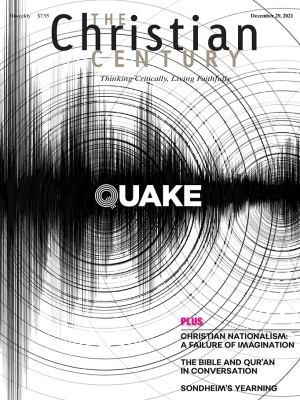Christian nationalism vandalizes the imagination
When churches whitewashed their walls, they left themselves vulnerable.

The insurrection at the US Capitol a year ago felt like an inevitable culmination of the violent rhetoric surrounding the 2020 election. But it also left many of us with questions. Why were Trump supporters so convinced by his claims about the election? And why were there so many Christian symbols and phrases mixed in with the Trump banners, MAGA hats, and Confederate flags?
A wealth of articles and books on Christian nationalism followed, all trying to make sense of these difficult questions. But just as brain surgery cannot fix a blocked artery, intellectual inquiry can’t solve a crisis of the imagination. Christian nationalism has a pernicious imaginative power. To address it, we need to recover the Christian tradition of cultivating the imagination as a spiritual practice.
Read our latest issue or browse back issues.
Phantasma, the Greek word for imagination, is related to the word for light, and like light, the imagination filters or shades how we see reality. It shapes our perception of the world around us. Though the imaginative eye certainly has some connections to our physical eyes, it might be better to compare it to the gut. The imaginative eye needs to be fed, and what we feed it vastly affects our overall well-being. If we offer it a nutritious, well-rounded diet, we can see more clearly; if we feed it a limited or unhealthy diet, we may be more susceptible to disease.
While the imaginative eye adapts and changes depending on what it consumes, its diet has largely been the same for more than a millennium: stories, images, and rituals. Jesus’ use of parables—along with the fact that much of the Bible is narrative and poetry—reminds us that God’s truth, too, is revealed through the work of the imagination. It doesn’t just inform; it delights, connects, and relates.
Christians of other times intentionally cultivated the imagination because they understood that we become what we behold. Spiritual formation literally required a form. Even the word character comes from the Greek kharakter, a stamp that impresses an image. Medieval Christians compared the soul to a wax tablet and considered the exercise of the imagination such an essential part of spiritual formation that they called it “the art of fashioning the soul.”
The first generations of Christians began developing a distinctively Christian imagination by intertwining symbols, stories, rituals, and beliefs. The fish symbol, or ichthys, is a very early profession of faith in which the Greek word for fish became an anagram for Jesus: (i) Christ (ch), God’s (th) Son (y), Savior (s). Early Christians also used anchors, phoenixes, palm branches, and a number of other symbols as a way to profess their beliefs. For most of Christian history, the imagination—in the form of stained-glass windows, frescoes, morality plays, personifications of the virtues and vices, sculptures, and a multitude of other forms—played a fundamental role in spiritual formation.
But during the Reformation, some Protestants distanced themselves from the works of the imagination as a way to distance themselves from the Roman Catholic Church. Some of them literally whitewashed the images on church walls. While some Protestant traditions still incorporate traditional forms of the imagination, a significant number of churches mostly do not. Their worship rituals typically are limited to singing, praying, and listening to the sermon. Art is rare. There may be background decor; there may even be a cross. But the focal points are screens, a stage, singers, and a speaker.
Though many of today’s worship spaces lack traditional signs of a distinctively Christian imagination, the imagination is not starving itself. It’s simply finding its food elsewhere. If we don’t cultivate a distinctively Christian imagination rooted in historic orthodoxy, we risk consuming alternative imaginations in its stead. In many places, blank exterior walls are likely to be vandalized with graffiti. Painting a mural on a wall, however, significantly reduces the odds that it will be tagged.
What if we thought of Christian nationalism as a particularly prolific vandal? When we whitewashed our church walls, did we unintentionally leave our imaginations open to other markings, markings that left impressions on our souls?
Christian nationalism offers a powerful imaginative framework. Its mythic origin story depicts America as uniquely blessed by God. But that relationship is under threat and must be defended by strong, protective heroes. Christian nationalism has slogans (God Bless America, MAGA, Take America Back for God); songs (“God Bless the U.S.A.,” etc.); and an assortment of images that often include Jesus’ name, the Bible, or the cross combined with American flags, eagles, and even guns. It is persuasive because its imaginative framework provides a cohesive sense of identity and purpose: I am part of this special place blessed by God and have been tasked to protect that relationship.
In Taking America Back for God, Andrew Whitehead and Samuel Perry conclude that Christian nationalism “does not encourage high moral standards or value self-sacrifice, peace, mercy, love, justice, and so on” but is instead “all about power.” Kristin Kobes Du Mez likewise points out in Jesus and John Wayne that White evangelicals haven’t voted for candidates who “shared their faith tradition” so much as for those who share “a broader set of deeply held values communicated through symbol, rituals, and political allegiances.”
In other words, when it comes to Christian nationalism, a shared imagination indicates a sense of belonging and identity more reliably than one of shared creeds or morals.
If we wish to bridge this gap between the orthodox creeds of Christianity and the persuasive, identity-forming power of the imagination, we can turn to the historic Christian tradition for guidance. Recovering an understanding of the imagination as essential to spiritual formation and rediscovering the treasure trove of stories, images, rituals, and practices bequeathed to us can provide both the theory and the practice to begin moving forward.
Two such gifts to consider are iconography and Ignatian contemplative prayer. Both are simple yet powerful imaginative practices that interlace image, story, and ritual.
When I first saw an icon, I dismissed its strange appearance, assuming that whoever made it simply hadn’t learned to paint very well. It surprised me to learn that icons are intended to be strange. Familiar images of Jesus tend to function like a mirror, in which we recognize ourselves and therefore leave the image unchanged. But icons defamiliarize us, deliberately unsettling and disorienting us so that they can invite us to encounter a different reality. An icon is not a self-reflection but a window that transports the viewer from the earthly to the sacred.
A Christ Pantocrator icon, for instance, offers a startling alternative to the Jesus images seen in many Christian gift shops today, in which Jesus tends to look like a man of White European descent. Christ Pantocrator uses reverse perspective, meaning that the viewer, not the image, is the focal point—a technique that reminds viewers that the icon’s purpose is not simply for us to look at it with our eyes. The point is for us to be transformed by the eyes that look back at us. Christ is not made over into any viewer’s likeness. We are made over into Christ’s likeness.
Icons also merge imagination with doctrine. In contrast to images in which Christian symbols are put into the service of unorthodox beliefs and nationalist sentiments, icons such as the Christ Pantocrator are embedded with symbols of credal Christian belief. The Pantocrator icon highlights Christ’s twofold nature. The red of his clothing represents his humanity: the red earth, his shed blood. So does the fact that the left side of his face is darker and more hollowed out than the right: it’s the darkened face of the Word made flesh, with all its pains and burdens.
The brighter right side of his face reflects his divinity. Jesus’ left eye is stern, to remind us of Christ’s role as judge. His kindly right eye, however, reminds us that he who judges us has already granted us mercy through his death. Finally, he holds his hand in a sign of blessing, with two fingers pointed up as a reminder that he is both fully human and fully divine. The other three fingers touch to symbolize the Trinity.
In some Pantocrator images, Jesus is holding a closed book, a reminder that “it is finished”: his birth, life, death, and resurrection fulfilled the prophecies and promise of the Jewish scriptures. (Depictions of the annunciation, on the other hand, show Gabriel visiting Mary with an open book, to signal that the story is still unfolding.) The three dots on the book are yet another sign of the Trinity, with the four sets of dots indicating the four Gospels in which Christ’s story is told.
Looking at an icon during prayer, then, effectively overlaps practice, image, and creed. Icons remind us that while we are created in the image of God, we ought not to make God into our own image. Contemplating the strangeness or otherness of Jesus and the otherworldliness of the divine kingdom reminds us that we are first and foremost citizens of God’s kingdom, not an earthly kingdom. And since icons also feature faces of saints from around the world, they enlarge our view of the church beyond the United States.
While icons disorient through an encounter with the otherness of God, Ignatian contemplative prayer requires a searching, creative imaginative process that asks us to envision biblical stories as if they were unfolding before us.
Ignatian prayer imitates Ezekiel eating the scroll by activating the imagination and effectively inserting oneself into scripture as a way to live into—and live out—its words. For instance, after reading about the annunciation, we would imaginatively insert ourselves into the story. What would it feel like to be Mary, hearing those words? What did she see, feel, touch, smell? Was her heart racing, her brain questioning her sanity, her eyes overwhelmed by Gabriel’s light? Imagine the scene from different perspectives. How might it feel to be Gabriel, announcing those words? Or to hide behind a bush, watching it all unfold? In this kind of practice, we do not just read scripture passively but become active participants in its unfolding story.
If we are meant to understand our stories as part of the biblical story, then inserting ourselves into the narratives trains us to see God’s character—and to imitate (to become) the people of faith in scripture. Appealing to the senses and therefore engaging the body, in addition to actively engaging the creative mind, ensures that our interaction with scripture is not a disengaged, distant activity but an active internalization of what is being read—and a very tangible way of seeing our own story as embedded within the gospel story, as opposed to any rival story.
Of course, such traditional practices are not enough to combat competing imaginations like Christian nationalism. But we need to do more than just dismantle and deconstruct. Practices like iconography and Ignatian contemplative prayer can offer a way forward. Intentionally cultivating the imagination can begin to help replace the red, white, and blue of American Jesus with the rather unsettling Jesus of the gospel. We worship a distinctive, peculiar Savior, and if we wish to be citizens of the kingdom of heaven, we need to train our eyes to see the distinctive, peculiar light pointing the way.
A version of this article appears in the print edition under the title “A vandalized imagination.”





